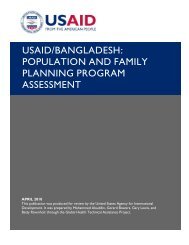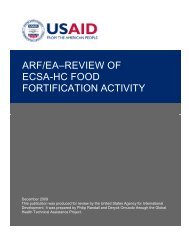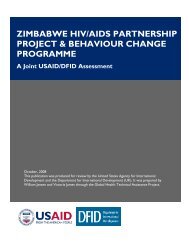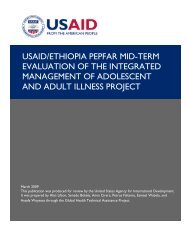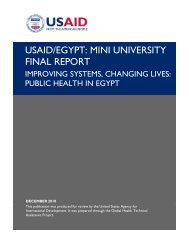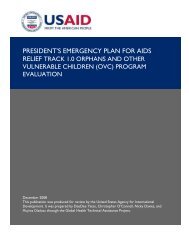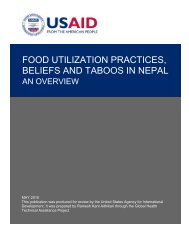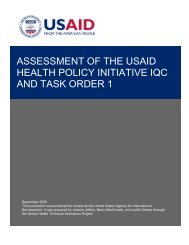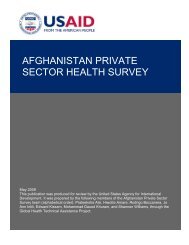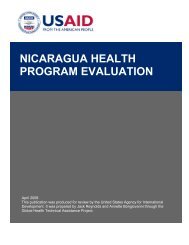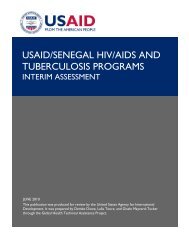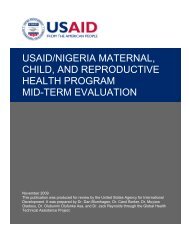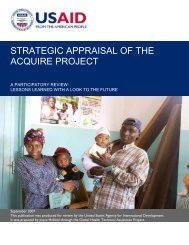Evaluation of the Tuberculosis Control Assistance Program (TB CAP)
Evaluation of the Tuberculosis Control Assistance Program (TB CAP)
Evaluation of the Tuberculosis Control Assistance Program (TB CAP)
Create successful ePaper yourself
Turn your PDF publications into a flip-book with our unique Google optimized e-Paper software.
C. PARTNERS AND PARTNER COORDINATIONThe <strong>TB</strong> <strong>CAP</strong> partnership model is unusual for USAID but is working well and allows for flexibility,innovation, strength-in-diversity, and acceptability to countries. Missions and NTPs appreciate <strong>the</strong> rangeand flexibility <strong>of</strong> <strong>TB</strong> <strong>CAP</strong> TA. There is a consensus that <strong>TB</strong> <strong>CAP</strong>’s current partners represent <strong>the</strong> rightmix <strong>of</strong> capabilities, although some areas need streng<strong>the</strong>ning.Partners reported that working toge<strong>the</strong>r in <strong>TB</strong> <strong>CAP</strong> has benefited <strong>the</strong>m by increasing <strong>the</strong>ir own capacities,amplifying <strong>the</strong> impact <strong>of</strong> <strong>the</strong>ir work, and providing <strong>the</strong>m with an entry point into regions and countrieswhere <strong>the</strong>y o<strong>the</strong>rwise might not have operated. They also felt that <strong>TB</strong> <strong>CAP</strong> had improved cooperationbetween agencies and reduced competition. <strong>TB</strong> <strong>CAP</strong> support has brought <strong>the</strong>se organizations to <strong>the</strong> sametable and catalyzed consensus on standards and approaches so that <strong>the</strong>y are increasingly speaking withone voice. New synergies between partners likely would not exist if <strong>the</strong> activities if <strong>the</strong>re were nopartnership.While <strong>the</strong> technical quality and relevance <strong>of</strong> its assistance was highly praised, several individuals reportedinsufficient coordination <strong>of</strong> <strong>TB</strong> <strong>CAP</strong> activities in some countries, particularly in <strong>the</strong> first years <strong>of</strong> <strong>the</strong>project. One common issue was that <strong>the</strong> country coordinating partner had been ineffective. This wasusually addressed by finding a coordinating partner that was more capable <strong>of</strong> carrying out <strong>the</strong> work, but insome cases implementation was delayed. In countries where <strong>the</strong> <strong>TB</strong> <strong>CAP</strong> coordinating partner could havebenefitted from senior support from <strong>the</strong> home <strong>of</strong>fice, this is <strong>of</strong>ten not recognized or is insufficient.The USAID brand is associated with <strong>TB</strong> <strong>CAP</strong> activities, as is <strong>the</strong> <strong>TB</strong> <strong>CAP</strong> brand itself. Still, <strong>the</strong>re is someconfusion about what <strong>TB</strong> <strong>CAP</strong> is (donor or project), <strong>the</strong> role <strong>of</strong> USAID, and whe<strong>the</strong>r <strong>TB</strong> <strong>CAP</strong> or <strong>the</strong>partner is implementing <strong>the</strong> project. This is likely unavoidable given <strong>the</strong> high pr<strong>of</strong>ile <strong>of</strong> <strong>the</strong> partnersimplementing <strong>TB</strong> <strong>CAP</strong>. In <strong>the</strong> countries visited, <strong>the</strong> USAID brand was prominent.RecommendationsThe board should define clear policies and criteria for <strong>the</strong> selection <strong>of</strong> collaborating partners, such asconstraints on <strong>the</strong> number <strong>of</strong> partners involved in particular types <strong>of</strong> projects, to ensure optimalcomposition <strong>of</strong> project teams.The board should set a minimal acceptable amount <strong>of</strong> visiting supportive supervision for <strong>TB</strong> <strong>CAP</strong>field <strong>of</strong>ficers, and partners should maintain that level <strong>of</strong> support for all programs <strong>the</strong>y coordinate,increasing <strong>the</strong> amount based on <strong>the</strong> needs and capacity <strong>of</strong> field <strong>of</strong>ficers.The board should establish base criteria for measuring <strong>the</strong> performance <strong>of</strong> coordinating andcollaborating partners and set a policy for responding to both underperformance and unwillingness tocarry out agreed-upon responsibilities, and <strong>the</strong> PMU should develop systems for monitoring andregularly reporting on such issues to <strong>the</strong> board for action.Some partners are less effective than o<strong>the</strong>rs at coordinating country or core projects. These partnersshould remain collaborating partners and not be responsible for coordination.D. ADMINISTRATION AND MANAGEMENTThe PMU based within KNCV in The Hague facilitates meetings and discussion among <strong>TB</strong> <strong>CAP</strong>governing bodies (<strong>the</strong> board and working groups) and relies on <strong>the</strong> strategic guidance and decisions <strong>of</strong><strong>the</strong>se bodies to select <strong>TB</strong> <strong>CAP</strong> activities, balanced by direction received from Missions, NTPs, and <strong>the</strong><strong>TB</strong> <strong>CAP</strong> Cognizant Technical Officer (CTO) in Washington, D.C.The PMU routinely monitors <strong>TB</strong> <strong>CAP</strong> activities and payment to agents for work performed. Clear andaccurate details <strong>of</strong> <strong>the</strong>se activities must be communicated to USAID throughout each year in specificformats, ranging from qualitative information (project achievements) to technical data (performance and8 EVALUATION OF THE TUBERCULOSIS CONTROL ASSISTANCE PROGRAM (<strong>TB</strong> <strong>CAP</strong>)



